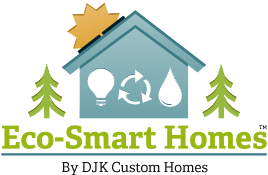Eco-Smart Technology: Lot Designs & Nature
Lot Designs & Nature
When designing the DJK "Grand Teton" eco-smart home we envisioned more of a nature preserve then we did a home site. We did not want to cause harm to nature and it's inhabitatant, instead we wanted to restore the lot to create a natural habitat for the areas local wildlife.
In order to reduce impact on the local environment and surrounding land we worked to minimize impact from the start. Our planning started all the way at lot selection and move forward throughout the project.
Eco-Smart Features
Site Selection
- DJK selected a home site that would best suit our visions for a natural yard with food, cover, and water for the areas wildlife. The home site was an infill lot with homes on three sides and open space to one side which is designated storm water detention space. The lot also had city sewer and water within 30 feet of the lot so it was easily accessible without having to disturb the community.
Lot Design for Drainage
- DJK selected a home site that would best suit our visions for a natural yard with food, cover, and water for the areas wildlife. The home site was an infill lot with homes on three sides and open space to one side which is designated storm water detention space.
Site Protection
- Throughout the building process DJK worked hard to protect existing trees on the property as well as to prevent soil erosion. Early in the process DJK used silt fencing to prevent soil erosion and fenced off all existing trees to prevent from damage due to construction activities. Storm sewer inlets were also protected through the use of straw bales.
No-Mow Grass
- Traditional lawn turf requires a great amount of watering and mowing. Not only are you using water but you are also burning fuel and causing polution with a traditional gas lawn mower. We chose to install No-mow grass seed from Prairie Nursery. This grass is a blend of several different fescues, which helps the turf to be drought tolerant. The turf also grows minimally and requires no mowing!
Native Drought Tolerant Plants
- One of the main goals of this project was to build an environment that was much like one would find in a natural forest preserve. We wanted to reduce watering needs as well as provide a natural habitat for birds, butterflies, and other animals. All plants that are part of the landscaping are native to the area.
Butterfly Habitat
- As part of our native landscaping plan we incorporated special butterfly seed blends. We planted groupings of wildflowers on the hill as well as within the detention basin. These plants include many of Monarch Butterfly's favorite plants to support them throughout the season.
Wildlife Habitat
- We wanted to create a beautiful yard that would attract wildlife from the area and give them a place to thrive. We believe that restoring natural habitat is an important part to maintiaining our eco-system. The backyard will be certified by the National Wildlife Federation as a Certified Wildlife Habitat.
Reduced Heat Island Effect
- It has been proven that urban areas are usually warmer than rural areas. This phenomenon is known as "Heat Island Effect". Every effort helps to reduce this warming. One way in which we reduced the heat island effect is by installing only light colored paving materials. The driveway and rear patio is paved with a light colored natural crushed stone, which reflects much less heat than asphalt.
Permeable Paving
- Permeable paving materials allow water to pass through and filter into the soil instead of running off into the sewer systems. All paving surfaces on this home site have a deep gravel base which allows water to filter through and into the ground.




